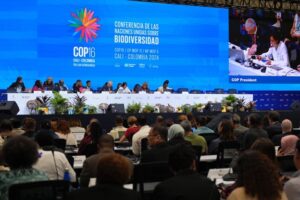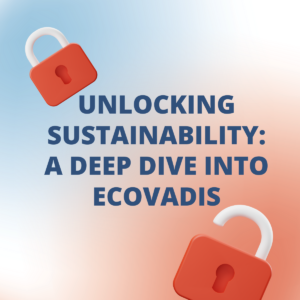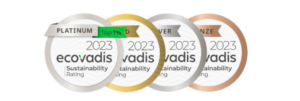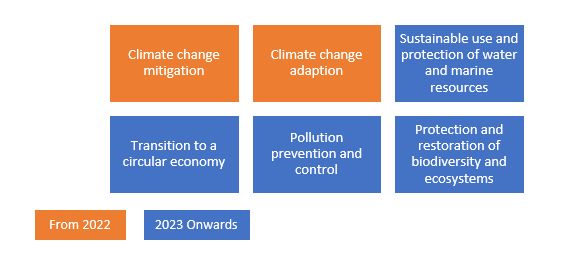 At COP16, 23,000 people representing 196 countries, over 100 ministers, over 3000 business delegates, civil society, Indigenous people and local communities, youth among others, gathered in Cali, Colombia, for the 16th Conference of the Parties to the Convention on Biological Diversity (CBD COP16). Held over 2 weeks as the first biodiversity COP since the adoption of the Kunming-Montreal Global Biodiversity Framework (KMGBF) two years ago, COP16 marked a significant milestone in global biodiversity conservation efforts to accelerate the implementation of the KMGBF and its 23 targets.
At COP16, 23,000 people representing 196 countries, over 100 ministers, over 3000 business delegates, civil society, Indigenous people and local communities, youth among others, gathered in Cali, Colombia, for the 16th Conference of the Parties to the Convention on Biological Diversity (CBD COP16). Held over 2 weeks as the first biodiversity COP since the adoption of the Kunming-Montreal Global Biodiversity Framework (KMGBF) two years ago, COP16 marked a significant milestone in global biodiversity conservation efforts to accelerate the implementation of the KMGBF and its 23 targets.
For over 2 weeks, the countries negotiated on critical items for the implementation of the KMGBF, including the need to close the biodiversity financing gap, the role of Indigenous Peoples and Local Communities (IPLCs) and private sectors in the implementation of the KMGBF. After a 24-hour non-stop negotiation on the last day, COP16 ended with some key agreements made and some being postponed to a later stage.
What is the Convention on Biological Diversity?
The Convention on Biological Diversity (CBD) is an international treaty established at the 1992 Earth Summit in Rio de Janeiro. The CBD aims to halt biodiversity loss and promote ecological sustainability through its three primary objectives: conserving biological diversity, promoting sustainable use of resources, and ensuring fair access and benefits. As of now, the CBD has been ratified by 196 countries, making it one of the most widely adopted international environmental agreements. This broad ratification underscores the global commitment to addressing biodiversity loss and working towards sustainable development.
What is COP16?
The Conference of the Parties (COP)is the governing body of the CBD and meets regularly to review progress and negotiate actions for biodiversity preservation. COP16, the 16th meeting of this body, was set to build upon the outcomes of the previous conference, COP15, which saw the adoption of the Kunming-Montreal Global Biodiversity Framework (GBF) in 2022. This framework outlines 23 targets for preserving global biodiversity by 2030, with one of the main targets aiming to protect 30% of Earth’s land and water and restore degraded ecosystems. Additionally, Target 15 focuses on mainstreaming biodiversity across sectors, pushing for all sectors to assess, disclose, and address their impacts and dependencies on nature.
What are the key outcomes of COP16?
Closer look at 6 key outcomes of COP16
1. Establishment of the Cali Fund to share the benefits derived from Digital Sequence Information
In a significant move towards equitable and fair sharing of financial resources from genetic resources, COP16 delegates agreed on a mechanism for benefit-sharing tied to genetic resources with the creation of the Cali Fund. A global fund dedicated to sharing the benefits derived from using digital sequence information (DSI) from genetic resources. This decision encourages large companies and other major entities within sectors such as biotechnology, Pharmaceutical, cosmetics, agribusiness, nutraceutical that benefit commercially from DSI to contribute a 1% of the profits derived from the use of DSI or 0.1% of their overall revenue to the fund. Half of the fund will be allocated to Indigenous Peoples and local communities, ensuring that those who are often the stewards of biodiversity receive fair compensation. The establishment of this fund, although not mandatory, sends a strong signal to global corporations that biodiversity is a shared global resource and the financial benefits derived from it should be shared equally, particularly with the IPLCs and developing countries that are stewards and custodians of nature.
2. Enhanced Role of Indigenous Peoples and Local Communities
One of the celebrated agreements at COP16 was the recognition of the role of Indigenous Peoples and Local Communities (IPLCs) through the establishment of a new permanent subsidiary body under Article 8(j) of the CBD Convention. This is the first Permanent body under a UN Convention and decision-making body to officially recognize the role and importance of traditional knowledge systems in global biodiversity conservation efforts. This is a significant milestone towards inclusive decision-making on issues around safeguarding nature.
3. Progress on updating National Biodiversity Strategy and Action Plans in line with the Kunming-Montreal Global Biodiversity Framework:
In adopting the KMGBF IN 2022, countries agreed to domesticate the Global plan into National Biodiversity Strategies and Action Plans (NBSAPs) outlining how each of the 23 KMGBF targets will be achieved at a national level and the actions and policy measures needed to achieve the target.
By the end of COP16,Out of 196 countries, only 44 countries had submitted National Biodiversity Strategy and Action Plans as the policy document which will support the implementation of these national targets at national level and Ireland is amongst the countries that have submitted their NBSAPs.119 countries submitted national biodiversity targets and of all the GBF target, Target 15 focuses on companies acting, assessing and disclosing on nature and 80% of the countries have set a national target aligned with target 15.
4. Launch of a Global Mainstreaming Champions Group to push for Mainstreaming of Biodiversity across sectors:
One of the significant agenda items at COP 16 for business delegates was the mainstreaming of biodiversity across various sectors, which is Target 15 of the KMGBF. This involves integrating biodiversity considerations into business operations, policies, and decision-making processes. 18 national governments announced the establishment of a Mainstreaming Champions Group to drive progress on biodiversity mainstreaming and embed the targets and goals of the Global Biodiversity Framework within and across all sectors of the economy. This is a positive step towards ensuring the involvement of non-state actors, including business and finance, in the implementation of the GBF. More countries are expected to join this group.
5. Bridging the gap between biodiversity and climate goals
Biodiversity and climate change are intrinsically linked, and this relationship was a key focus of negotiations at COP16. Countries recognized the need to address the interconnections between biodiversity loss and climate change at both the national and international levels. As a result, they agreed to establish pathways for fostering collaboration in national policies under the three Rio Conventions: The Convention on Biological Diversity (CBD), the United Nations Framework Convention on Climate Change (UNFCCC), and the United Nations Convention to Combat Desertification (UNCCD). This synergy will also be a significant agenda item at UNFCCC COP29 in Baku, which is scheduled to take place just a week after COP16.
6. Postponement of key decisions around closing the biodiversity financing gap:
While several important agreements were reached, discussions regarding the establishment of a new Global Biodiversity Fund, which is essential to secure the $200 billion needed annually by 2030 to implement the KMGBF and support biodiversity efforts—particularly in the Global South and developing countries—were postponed due to disagreements over the financial mechanism. Under the framework, parties agreed to raise $200 billion annually by 2030; however, the logistics of this fund are yet to be decided, stalling the implementation of biodiversity projects aimed at achieving the 23 targets of the GBF by 2030.
Business Engagements at COP16
COP16 saw a significant increase in the presence of business and finance corporations, with over 3,000 business delegates—a threefold increase from COP15—reflecting the growing recognition of the private sector’s role in biodiversity conservation and signaling that biodiversity, like Climate change is becoming a critical topic on the corporate agenda. This includes representatives from mining, pharmaceuticals, food, and agriculture and strong representation from financial services. Multiple side events and roundtables were co-organized by organizations including the Taskforce for Nature-Related Disclosures (TNFD), Global Reporting Initiative (GRI), CDP, and Science-Based Targets Network (SBTN). These events focused on nature transition plans, nature strategies, reporting, and the need for accurate and accessible nature data for companies to assess their impacts and dependencies on nature, as well as the interoperability among different frameworks and standards such as TNFD, CDP, CSRD, and GRI.
The Taskforce on Nature-related Financial Disclosures (TNFD) announced that over 500 organizations are now committed to voluntarily reporting their nature-related impacts and dependencies through the TNFD recommendations and approaches and launched their new guidance on nature transition planning. Additionally, SBTN announced the first companies to publicly adopt a science-based target for nature.
The high participation of the private sector and businesses reflects the urgent need for collective action and the recognition that sustainable development and biodiversity protection are interconnected.
What’s next?
COP 16 will resume at a later date and venue to adopt crucial agenda items, including a strategy for resource mobilization (biodiversity finance) and a monitoring framework for the KMGBF. The parties are yet to agree on a new strategy for resource mobilization to help secure $200 billion annually by 2030 from all sources to support biodiversity initiatives worldwide, in line with Target 19 of the KMGBF. The parties will also finalize the monitoring framework that will be used to measure progress against the 23 targets. The next Biodiversity COP 17 will be in 2026 in Armenia.
Conclusion
COP16 set the stage for significant advancements in biodiversity conservation, underscoring the urgent need for collaboration between governments, the private sector, and Indigenous Peoples and Local Communities and Civil Society. The establishment of the Cali Fund, recognition of IPLCs, and the push for mainstreaming biodiversity across sectors signal a shift towards greater accountability and a “whole of society “approach to halt biodiversity loss. As biodiversity and climate change are increasingly recognized as interconnected crises, these developments are crucial for building a resilient and equitable future for all.
 As climate change intensifies, businesses, governments, and financial institutions face growing pressure to adopt strong climate transition plans. These strategies are key to building a low-carbon, sustainable future and meeting global goals like the Paris Agreement.
As climate change intensifies, businesses, governments, and financial institutions face growing pressure to adopt strong climate transition plans. These strategies are key to building a low-carbon, sustainable future and meeting global goals like the Paris Agreement.

 At COP16, 23,000 people representing 196 countries, over 100 ministers, over 3000 business delegates, civil society, Indigenous people and local communities, youth among others, gathered in Cali, Colombia, for the 16th Conference of the Parties to the Convention on Biological Diversity (CBD COP16). Held over 2 weeks as the first biodiversity COP since the adoption of the Kunming-Montreal Global Biodiversity Framework (KMGBF) two years ago, COP16 marked a significant milestone in global biodiversity conservation efforts to accelerate the implementation of the KMGBF and its 23 targets.
At COP16, 23,000 people representing 196 countries, over 100 ministers, over 3000 business delegates, civil society, Indigenous people and local communities, youth among others, gathered in Cali, Colombia, for the 16th Conference of the Parties to the Convention on Biological Diversity (CBD COP16). Held over 2 weeks as the first biodiversity COP since the adoption of the Kunming-Montreal Global Biodiversity Framework (KMGBF) two years ago, COP16 marked a significant milestone in global biodiversity conservation efforts to accelerate the implementation of the KMGBF and its 23 targets.
 Goodbody Clearstream are delighted to share that Fran McNulty, Director Responsible Business is now a trained B Leader on the Irish B Leaders Database and can guide companies who are interested in B Corp certification.
Goodbody Clearstream are delighted to share that Fran McNulty, Director Responsible Business is now a trained B Leader on the Irish B Leaders Database and can guide companies who are interested in B Corp certification. What is EcoVadis?
What is EcoVadis?

 Non-financial and sustainability reporting has become an integral part of business operations over the last number of years. However, understanding climate risk and opportunity continues to prove a significant challenge for investors and corporates alike. The EU Taxonomy is part of the broader EU Action Plan on Sustainable Finance which seeks to offer clarity to investors and large companies in relation to the sustainability of their business operations. In doing so, it is anticipated that the taxonomy will create security for investors, prevent greenwashing, help companies to become more climate-friendly and help shift investments to more sustainable initiatives.
Non-financial and sustainability reporting has become an integral part of business operations over the last number of years. However, understanding climate risk and opportunity continues to prove a significant challenge for investors and corporates alike. The EU Taxonomy is part of the broader EU Action Plan on Sustainable Finance which seeks to offer clarity to investors and large companies in relation to the sustainability of their business operations. In doing so, it is anticipated that the taxonomy will create security for investors, prevent greenwashing, help companies to become more climate-friendly and help shift investments to more sustainable initiatives.